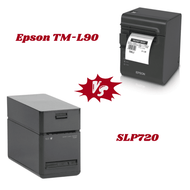SLP720 vs. Epson TM-L90: Which Printer Wins?
17th Oct 2025
Key Highlights
-
Both SLP720RT and Epson TM-L90 support linerless printing for eco-friendly, waste-free operation.
-
SLP720RT is faster (200 mm/sec), more compact, and holds larger rolls—ideal for high-volume, space-constrained setups.
-
Epson TM-L90 handles wider media (38–80 mm) and is known for durability (up to 2M cutter cycles).
-
SLP720RT helps lower costs with back-feed and reduced consumable usage.
-
Epson offers better software compatibility and connectivity across industries.
-
Choose SLP720RT for fast, cost-efficient label printing; TM-L90 for versatile, heavy-duty needs.
-
Let OmegaBrand help match the right printer to your unique business demands.
Choosing the right linerless label printer isn’t always easy. With so many options, businesses often struggle to figure out which model will deliver better speed, print quality, and reliability without overspending. The SLP720 and Epson TM-L90 are two popular choices, but understanding which one fits your needs can feel overwhelming. In this blog, we break down their key differences and strengths, so you can make a clear, confident decision for your business.
Why Compare the SLP720RT and Epson TM-L90 for Linerless Printing?
Linerless label printing is becoming the preferred choice for businesses that want to cut waste, save storage space, and improve efficiency. Both the SLP720RT and the Epson TM-L90 are popular printers designed for this purpose, but they serve slightly different needs.
Comparing them helps businesses understand differences in print speed, label compatibility, and durability before making an investment. By looking at both side by side, it becomes easier to identify which printer aligns with your daily volume, operational environment, and long-term cost goals.
What Are the Key Features of SLP720RT and Epson TM-L90?
The SLP720RT offers high-resolution printing, versatile media handling, and eco-friendly linerless capabilities. In contrast, the Epson TM-L90 features fast print speeds and reliable performance for various applications. Both printers cater to unique business needs with their distinct functionalities.
1. SLP720RT Overview
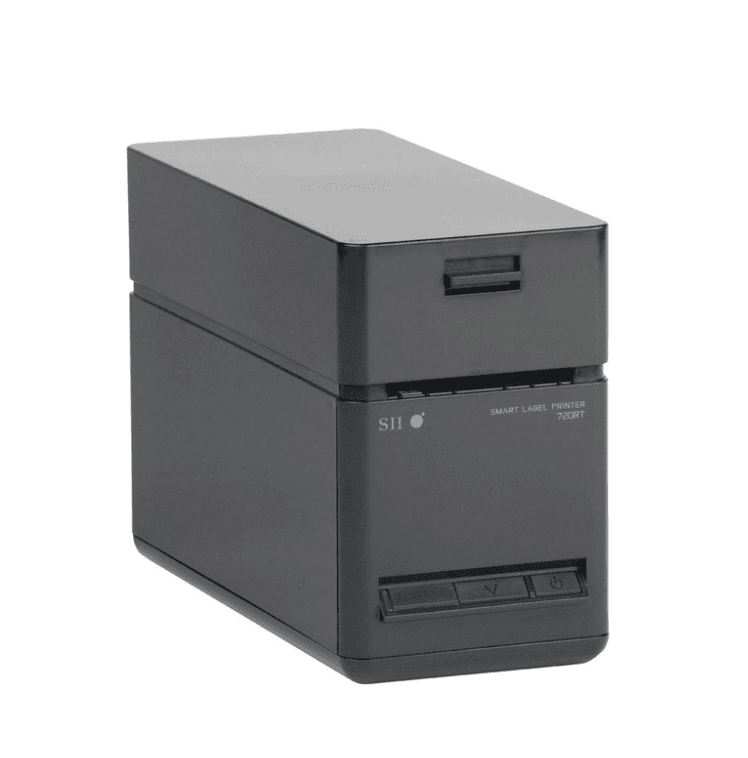
The SLP720RT is a compact direct thermal linerless printer designed for fast and efficient label production. It suits environments where space is limited but consistent output is critical, such as retail counters and logistics stations. Its support for linerless labels reduces waste while the built-in cutter and high print speed ensure smooth, uninterrupted workflows.
-
Print Resolution: 203 dpi
-
Print Speed: Up to 200 mm/sec
-
Connectivity: USB, LAN, optional wireless
-
Media Handling: Linerless labels, receipts, and standard labels up to 54 mm wide
-
Design: Lightweight and compact (90 × 200 × 141 mm, ~1.1 kg)
-
Durability: Auto-cutter lifespan up to 1,000,000 cuts
2. Epson TM-L90 Overview
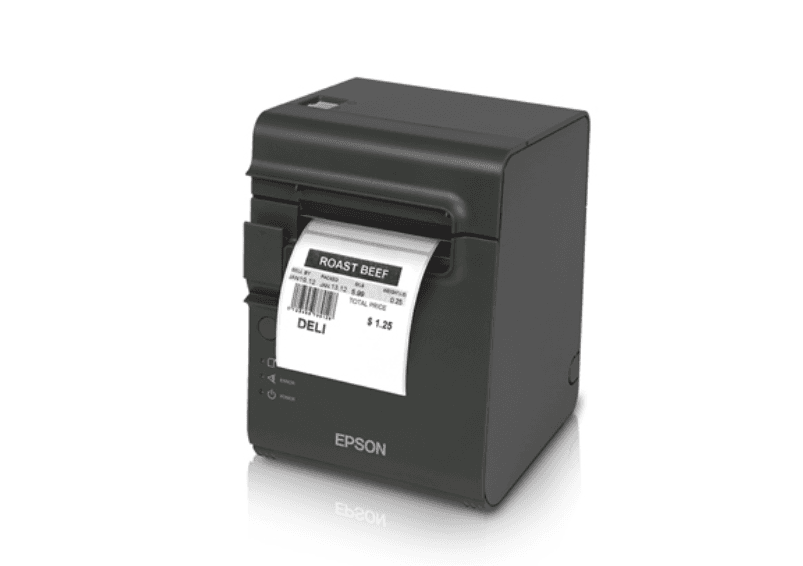
The Epson TM-L90 is a versatile linerless and label printer built for high-volume environments. It combines reliable thermal printing with flexible paper width options, making it suitable for applications ranging from retail to food service. With Epson’s durable build quality and flexible mounting options, it adapts well to different workspace layouts.
-
Print Resolution: 203 dpi
-
Print Speed: Up to 150 mm/sec
-
Connectivity: USB, serial, parallel, Ethernet
-
Media Handling: Labels and receipts, multiple widths (38, 60, 80 mm), roll diameter up to 90 mm
-
Design: Sturdy build (140 × 148 × 203 mm, ~1.9 kg)
-
Durability: Auto-cutter rated for up to 2 million cuts
Explore Epson Printers for Your Business Needs – Browse Models Now!
What Makes Each Printer Unique?
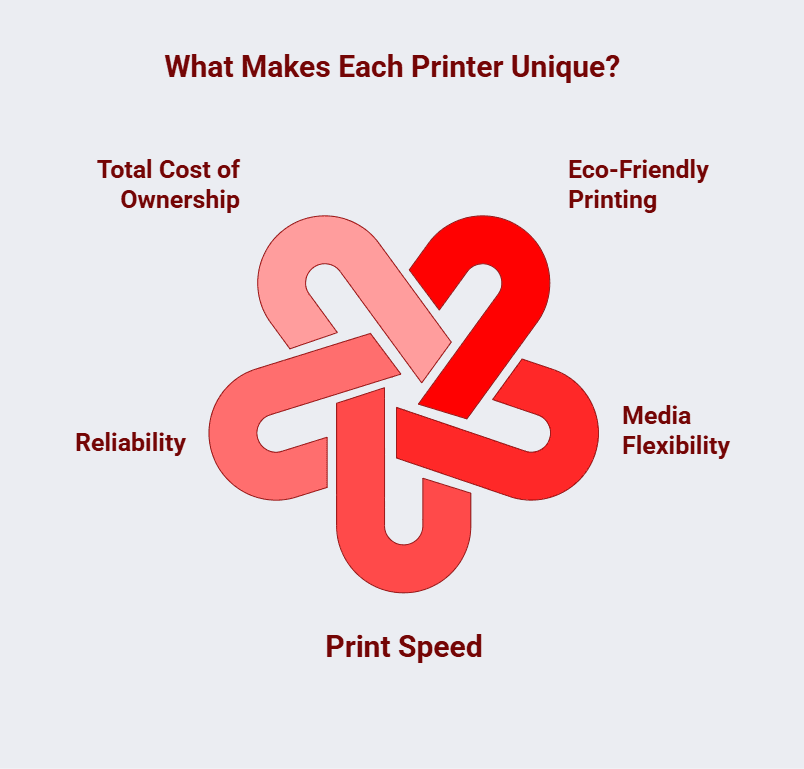
When comparing the SLP720RT and Epson TM-L90, both excel in thermal printing for labels and receipts, but each model has distinctive strengths that cater to different business needs. Below, we break down their unique differentiators.
1. Eco-Friendly and Linerless Printing Capabilities
Both printers excel in eco-friendly and linerless printing capabilities, making them great choices for environmentally conscious users. The SLP720RT utilizes a design that minimizes waste by eliminating the need for liner materials.
The Epson TM-L90 supports various linerless label formats, enhancing sustainability. Additionally, both models leverage thermal printing technology, reducing energy consumption. Their compatibility with eco-friendly media reflects a commitment to sustainability, allowing businesses to reduce their carbon footprint while enjoying efficient receipt and label printing.
2. Media Flexibility and Supported Widths
Each printer stands out with its capacity to handle various media types, catering to diverse printing needs. The SLP720RT allows for a wider range of label widths, accommodating anything from standard shipping labels to custom-sized formats.
In comparison, the Epson TM-L90 specializes in receipt printing, ensuring consistent performance with various receipt widths. Both devices excel at producing high-quality outputs, but the SLP720RT shines in versatility, making it a go-to option for those requiring flexibility in their linerless printing solutions.
3. Print Speed and Throughput
Both the SLP720RT and the Epson TM-L90 stand out when it comes to print speed and throughput. The SLP720RT boasts a maximum print speed that caters well to high-demand environments, efficiently processing liner labels with minimal wait time.
Similarly, the Epson TM-L90 impresses with its robust capabilities in receipt printing and shipping labels, ensuring swift delivery of prints. With their advanced thermal technology and seamless USB and Ethernet interfaces, these printers are designed to enhance your workflow and meet the needs of busy retail environments.
4. Reliability and Maintenance Requirements
Both the SLP720RT and Epson TM-L90 excel in reliability and maintenance, ensuring smooth operations for any business. The SLP720RT’s thermal printing technology minimizes wear, while its durable construction promises longevity.
Meanwhile, the Epson TM-L90 features a proven design that simplifies maintenance with user-friendly access to its components. Regular upkeep is straightforward for both printers, allowing for efficient performance. Their robust builds and ease of maintenance make them excellent choices for consistent and hassle-free printing, whether it’s receipts or shipping labels.
5. Total Cost of Ownership (TCO)
When choosing a printer, the initial purchase price is only part of the story. The Total Cost of Ownership (TCO) includes the upfront cost, consumables like paper, and potential maintenance. Which printer costs less over time?
The Seiko SLP720RT is designed to actively reduce the cost of consumables. Its initial price is competitive, and its features help lower ongoing expenses.
-
Back-Feed Feature: This paper-saving function can significantly reduce media consumption over the printer's life.
-
Linerless Media: Using linerless rolls means you get more labels per roll, reducing the cost per label and the frequency of reordering.
The Epson TM-L90 also has paper-saving options, but the SLP720RT's back-feed feature gives it a direct advantage in minimizing media waste. While both printers eliminate the cost of ink by being thermal, the SLP720RT’s focus on reducing paper usage with every print gives it a potential edge for lower long-term ownership costs related to consumables.
Which Printer Performs Best in Different Use Cases?
The SLP720RT is best suited for environments where linerless label printing and speed are the top priorities—such as quick-service restaurants, takeaway counters, and back-of-house food prep stations. Its compact size, label-taken sensor, and high throughput make it ideal for operations where staff need labels printed fast and waste-free.
The Epson TM-L90, by contrast, excels in multi-purpose retail and healthcare settings. Its ability to handle wider rolls (up to 80 mm) makes it perfect for supermarkets, pharmacies, and logistics hubs that need large-format labels or variable-width receipts. Its durability also makes it well-suited for high-traffic point-of-sale environments.
What Are the Pros and Cons of SLP720RT vs Epson TM-L90?
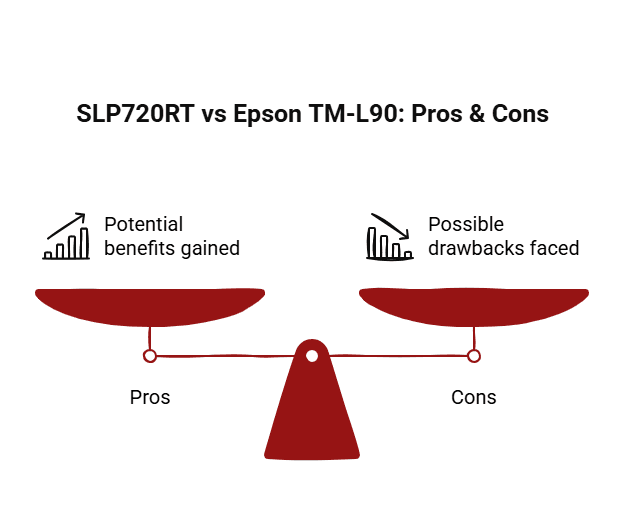
SLP720RT – Pros:
-
Faster print speed (200 mm/sec) for quicker throughput
-
Compact, lightweight design fits small spaces
-
Linerless printing reduces waste and supports sustainability
-
Label-taken sensor prevents jams and overlaps
-
Larger roll capacity (102 mm diameter) than Epson
SLP720RT – Cons:
-
Limited to narrower media widths (max 58 mm)
-
Lower cutter life (~1 million cuts vs Epson’s 2 million)
-
Ecosystem and driver support not as extensive as Epson
Epson TM-L90 – Pros:
-
Supports a wider range of media widths (38–80 mm)
-
Proven reliability with long cutter life (up to 2 million cuts)
-
Strong software/driver ecosystem (OPOS, JavaPOS, SDKs)
-
Flexible use for labels, tickets, and receipts
-
Well-established in retail and POS environments
Epson TM-L90 – Cons:
-
Slower maximum print speed (150 mm/sec)
-
Bulkier and heavier than the SLP720RT
-
Linerless capability only available in certain versions
-
Smaller roll capacity (90 mm max diameter)
Which Printer Should You Ultimately Buy? Our Verdict

If your business requires fast, waste-free linerless label printing, the SLP720RT is the clear winner. It’s compact, eco-friendly, and designed for high-speed operations.
If you need a versatile, heavy-duty label and receipt printer with proven reliability, the Epson TM-L90 offers a better long-term investment, especially if you need wider labels and POS integration.
What’s the Bottom Line for Linerless Label Printing?
Linerless printing isn’t just eco-friendly—it cuts waste, lowers costs, and boosts efficiency. Without backing liners, businesses save on disposal fees, gain more labels per roll, and reduce roll changes. This speeds up operations, saves storage space, and supports sustainability goals.
The SLP720RT is purpose-built for linerless use, with features like a label-taken sensor to prevent overlaps. The Epson TM-L90 supports linerless in some models but treats it as an add-on rather than a core feature.
In short: If linerless printing is a priority, choose the SLP720RT. If you need broader media flexibility, the Epson TM-L90 is the safer bet.
Struggling to Choose the Right Printer? OmegaBrand Makes It Easy
At OmegaBrand, we understand that every detail matters, from print speed to media type. Our team of experts has helped countless businesses like yours find the ideal hardware for their unique needs. We can help you choose the right printer for your specific operational demands.
Don't spend another hour trying to decipher spec sheets. Let us help you find the perfect receipt printer or linerless label solution. We'll listen to your requirements and recommend a printer that not only meets your needs today but will also support your growth tomorrow. Contact OmegaBrand for a personalized consultation and take the guesswork out of your next hardware purchase.
Conclusion
In conclusion, choosing between the SLP720 and the Epson TM-L90 ultimately depends on your specific needs and priorities. Both printers offer unique features that cater to various business applications, from eco-friendly printing to high-speed performance. By analyzing factors such as print speed, media flexibility, and total cost of ownership, you can make a well-informed decision that best fits your operational requirements. Remember, investing in the right printer not only enhances productivity but also contributes to sustainability efforts. If you're still unsure which option is the best for you, don’t hesitate to reach out to OmegaBrand for expert assistance in selecting the perfect printer for your needs!
Frequently Asked Questions
Is the Epson TM-L90 compatible with linerless labels?
Yes, specific models of the Epson TM-L90 are compatible with linerless labels. You need to look for the Epson TM-L90 LFC (Liner-Free Compatible) printer. This version is specially designed to handle the adhesive-backed media used in linerless printing, making it a versatile label printer.
How does the print speed of SLP720RT compare to that of TM-L90?
The Seiko SLP720RT is faster. It boasts a maximum print speed of 200mm/sec, while the Epson TM-L90 prints at up to 170mm/sec. This makes the SLP720RT about 15-20% faster, which is a significant advantage for high-volume receipt printing or label production.
Do they have the same print resolution?
The SLP720RT and Epson TM-L90 feature different print resolutions, with the SLP720RT offering a higher resolution for precise images. This distinction impacts overall print quality, making it essential to consider your specific needs when choosing between these two printers.
Which has better connectivity options (wifi, Ethernet, etc.)?
Both printers offer excellent connectivity. The Seiko SLP720RT is available in a USB & Ethernet model or a dedicated Wi-Fi model. The Epson TM-L90 comes standard with a USB port plus a second modular interface (like Ethernet or Serial), offering good flexibility for wired connections.
How do their size and footprint compare?
The Seiko SLP720RT has a much smaller footprint. Its dimensions are approximately 90 x 200 x 141 mm. The Epson TM-L90 is larger, measuring 140 x 148 x 203 mm. If counter space is a major concern, the compact hardware of the Seiko printer is the clear winner.
Which printer costs less over time, considering consumables?
The Seiko SLP720RT likely costs less over time. Its unique back-feed feature actively minimizes paper waste on every print, which can lead to significant savings on consumables. While both use cost-effective thermal printing, the SLP720RT's design provides a direct advantage in lowering long-term ownership costs.
Is the SLP720RT better for reducing paper waste?
Yes, the SLP720RT is arguably better for reducing paper waste. Its support for linerless media is a great eco-friendly start, but its built-in back-feed feature, which eliminates blank lead-in space on labels, actively reduces media consumption, making this printer an excellent choice for sustainability.

